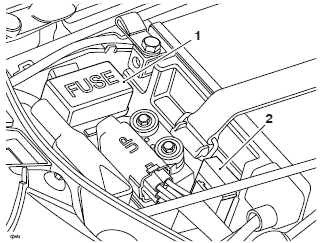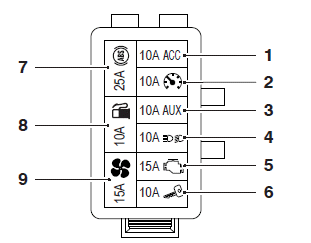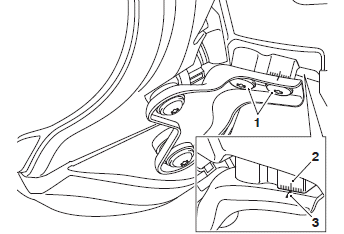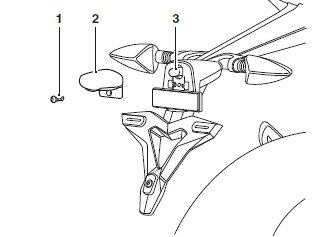 Triumph Street Triple S - Owner's Manual > Battery
Triumph Street Triple S - Owner's Manual > Battery
Warning: The battery contains sulfuric acid (battery acid). Contact with skin or eyes may cause severe burns. Wear protective clothing and a face shield.
If battery acid gets on your skin, flush with water immediately.
If battery acid gets in your eyes, flush with water for at least 15 minutes and SEEK MEDICAL ATTENTION IMMEDIATELY.
If battery acid is swallowed, drink large quantities of water and SEEK MEDICAL ATTENTION IMMEDIATELY.
KEEP BATTERY ACID OUT OF THE REACH OF CHILDREN.
Warning: Under certain circumstance the battery may release explosive gases.
Make sure to keep all sparks, flames away from the battery.
Do not attach jump leads to the battery, touch the battery cables together or reverse the polarity of the cables, as any of these actions may cause a spark which would ignite battery gases causing a risk of personal injury.
Make sure that there is adequate ventilation when charging or using the battery in an enclosed space.
Warning: The battery contains harmful materials. Always keep children away from the battery at all times.
Battery Removal
Warning: Make sure that the battery terminals do not touch the motorcycle frame.
This may cause a short circuit or spark which would ignite battery gases causing a risk of personal injury.

- Battery
- Positive (red) terminal
- Negative (black) terminal
- Battery strap
To remove the battery:
- Remove the passenger and rider's seats.
- Remove the battery strap.
- Disconnect the battery leads, negative (black) lead first and then the positive lead.
- Remove the battery from its housing.
Battery Disposal
Should the battery ever require replacement, the original battery must be handed to a recycling agent who will make sure that the dangerous substances from which the battery is manufactured do not pollute the environment.
Battery Maintenance
Warning: Battery acid is corrosive and poisonous and will cause damage to unprotected skin.
Never swallow battery acid or allow it to come into contact with the skin.
To prevent injury, always wear eye and skin protection when handling the battery.
The battery is a sealed type and does not require any maintenance other than checking the voltage and routine recharging when required, such as during storage.
Clean the battery using a clean, dry cloth. Make sure that the cable connections are clean.
It is not possible to adjust the battery acid level in the battery; the sealing strip must not be removed.
Battery Discharge
Caution: The charge level in the battery must be maintained to maximize battery life.
Failure to maintain the battery charge level could cause serious internal damage to the battery.
Under normal conditions, the motorcycle charging system will keep the battery fully charged. However, if the motorcycle is unused, the battery will gradually discharge due to a normal process called self discharge; the clock, Engine Control Module (ECM) memory, high ambient temperatures, or the addition of electrical security systems or other electrical accessories will all increase this rate of battery discharge.
Disconnecting the battery from the motorcycle during storage will reduce the rate of discharge.
Battery Discharge During Storage and Infrequent Use of the Motorcycle
During storage or infrequent use of the motorcycle, inspect the battery voltage weekly using a multimeter. Follow the manufacturer's instructions supplied with the meter.
Should the battery voltage fall below 12.7 Volts, the battery should be charged.
Allowing a battery to discharge or leaving it discharged for even a short period of time causes sulphation of the lead plates. Sulphation is a normal part of the chemical reaction inside the battery, however over time the sulphate can crystallize on the plates making recovery difficult or impossible. This permanent damage is not covered by the motorcycle warranty, as it is not due to a manufacturing defect.
Keeping the battery fully charged reduces the likelihood of it freezing in cold conditions. Allowing a battery to freeze will cause serious internal damage to the battery.
Battery Charging
Warning: The battery gives off explosive gases; keep sparks, flames away. Provide adequate ventilation when charging or using the battery in an enclosed space.
The battery contains sulfuric acid (battery acid). Contact with skin or eyes may cause severe burns. Wear protective clothing and a face shield.
If battery acid gets on your skin, flush with water immediately.
If battery acid gets in your eyes, flush with water for at least 15 minutes and SEEK MEDICAL ATTENTION IMMEDIATELY.
If battery acid is swallowed, drink large quantities of water and SEEK MEDICAL ATTENTION IMMEDIATELY.
KEEP BATTERY ACID OUT OF THE REACH OF CHILDREN.
Caution: Do not use an automotive quick charger as it may overcharge and damage the battery.
For help with selecting a battery charger, checking the battery voltage or battery charging, contact your local authorized Triumph dealer.
Should the battery voltage fall below 12.7 Volts, the battery should be charged using a Triumph approved battery charger. Always remove the battery from the motorcycle and follow the instructions supplied with the battery charger.
For extended periods of storage (beyond two weeks) the battery should be removed from the motorcycle and kept charged using a Triumph approved maintenance charger.
Similarly, should the battery charge fall to a level where it will not start the motorcycle, remove the battery from the motorcycle before charging.
Battery Installation
Warning: Make sure that the battery terminals do not touch the motorcycle frame.
This may cause a short circuit or spark which would ignite battery gases causing a risk of personal injury.

- Battery
- Positive (red) terminal
- Negative (black) terminal
- Battery strap
To install the battery:
- Position the battery into its housing.
- Reconnect the battery, positive (red) lead first and then the negative lead.
- Tighten the battery terminals to 40 lbf in (4.5 Nm).
- Apply a light coat of grease to the terminals to prevent corrosion.
- Cover the positive terminal with the protective cap.
- Reinstall the battery strap.
- Re-install the rider and passenger seat.
Fuses
Warning: Always replace blown fuses with new ones of the correct rating (as specified on the fuse box cover) and never use a fuse of higher rating.
Use of an incorrect fuse could lead to an electrical problem, resulting in motorcycle damage, loss of motorcycle control and an accident.
Note: A blown fuse is indicated when all of the systems protected by that fuse become inoperative. When checking for a blown fuse, use the tables to establish which fuse has blown.
The fuse boxes are located underneath the rider's seat. To allow access to the fuse boxes, the rider's seat must be removed.

- Fuse box
- Main fuse (30 Amp)
Fuse Identification
Spare fuses are located on the inside of the fuse box cover and should be replaced if used.

Fuse Box

Headlights

Warning: Adjust road speed to suit the visibility and weather conditions in which the motorcycle is being operated.
Make sure that the head light beam is adjusted to illuminate the road surface sufficiently far ahead without blinding oncoming traffic.
An incorrectly adjusted headlight may impair visibility causing an accident.
Warning: Never attempt to adjust a headlight beam when the motorcycle is in motion.
Any attempt to adjust a headlight beam when the motorcycle is in motion may result in loss of control and an accident.
Caution: Do not cover the headlight or lens with any item likely to obstruct air flow to, or prevent heat escaping from, the headlight lens.
Covering the headlight lens during operation with items of clothing, luggage, adhesive tape, devices intended to alter or adjust the headlight beam or non genuine headlight lens covers will cause the headlight lens to overheat and distort, causing irreparable damage to the headlight assembly.
Damage caused by overheating is not considered a manufacturing defect and will not be covered under warranty.
If the headlight must be covered during use - such as taping of the headlight lens required during closed‑course conditions - the headlight must be disconnected.
Headlight Adjustment
The vertical beams of the left and right hand headlights can only be adjusted together. Independent adjustment is not possible.

- Headlight bracket bolts
- Front subframe alignment marks
- Headlight bracket mark
To vertically adjust the headlights:
- Switch the ignition on. The engine does not need to be running.
- Switch the headlight dipped beam on.
- Loosen the two headlight bracket bolts securing the headlight bracket to the front subframe sufficiently to allow restricted movement of the headlights.
- Using the headlight bracket mark and the alignment markings on the front subframe, adjust the position of the headlights to give the required beam setting. Each alignment mark on the subframe represents 1º.
- Moving the headlight bracket forwards moves the headlight upwards. Moving the headlight bracket rearwards moves the headlights downwards.
- Tighten the headlight bracket bolts to 62 lbf in (7 Nm).
- Recheck the headlight beam settings.
- Switch the headlights off when the beam settings are satisfactorily set.
Headlight Replacement
The headlight unit is a sealed, maintenance free LED unit. The headlight unit must be replaced in the event of the failure of the headlight.
Brake/Tail Light
The LED brake/tail light units are sealed, maintenance free LED units. The brake/ tail light assembly must be replaced in the event of the failure of the brake/tail light.
License Plate Light
Bulb Replacement

- Fastener
- Lens
- Bulb
To replace the license plate light bulb:
- Loosen the fastener and remove the lens of the license plate light.
- Replace the bulb.
- Re-install the lens and tighten the fastener to 9 lbf in (1 Nm).
See also:
 Triumph Street Triple S - Owner's Manual > Tires
Triumph Street Triple S - Owner's Manual > Tires
This model is equipped with tubeless tires, valves and wheel rims. Use only tires marked 'TUBELESS' and tubeless valves on rims marked 'SUITABLE FOR TUBELESS TYRES'.
 Triumph Street Triple S - Owner's Manual > Cleaning and Storage, Specifications
Triumph Street Triple S - Owner's Manual > Cleaning and Storage, Specifications
Cleaning and Storage Cleaning Frequent, regular cleaning is an essential part of the maintenance of your motorcycle. If regularly cleaned, the appearance will be preserved for many years.

 Benelli Imperiale 400
Benelli Imperiale 400 BMW F900XR
BMW F900XR Honda CB500X
Honda CB500X KTM 390 Adventure
KTM 390 Adventure Triumph Street Triple S
Triumph Street Triple S Yamaha MT-03
Yamaha MT-03 Kawasaki Z400
Kawasaki Z400 Triumph Street Triple S
Triumph Street Triple S Yamaha MT-03
Yamaha MT-03